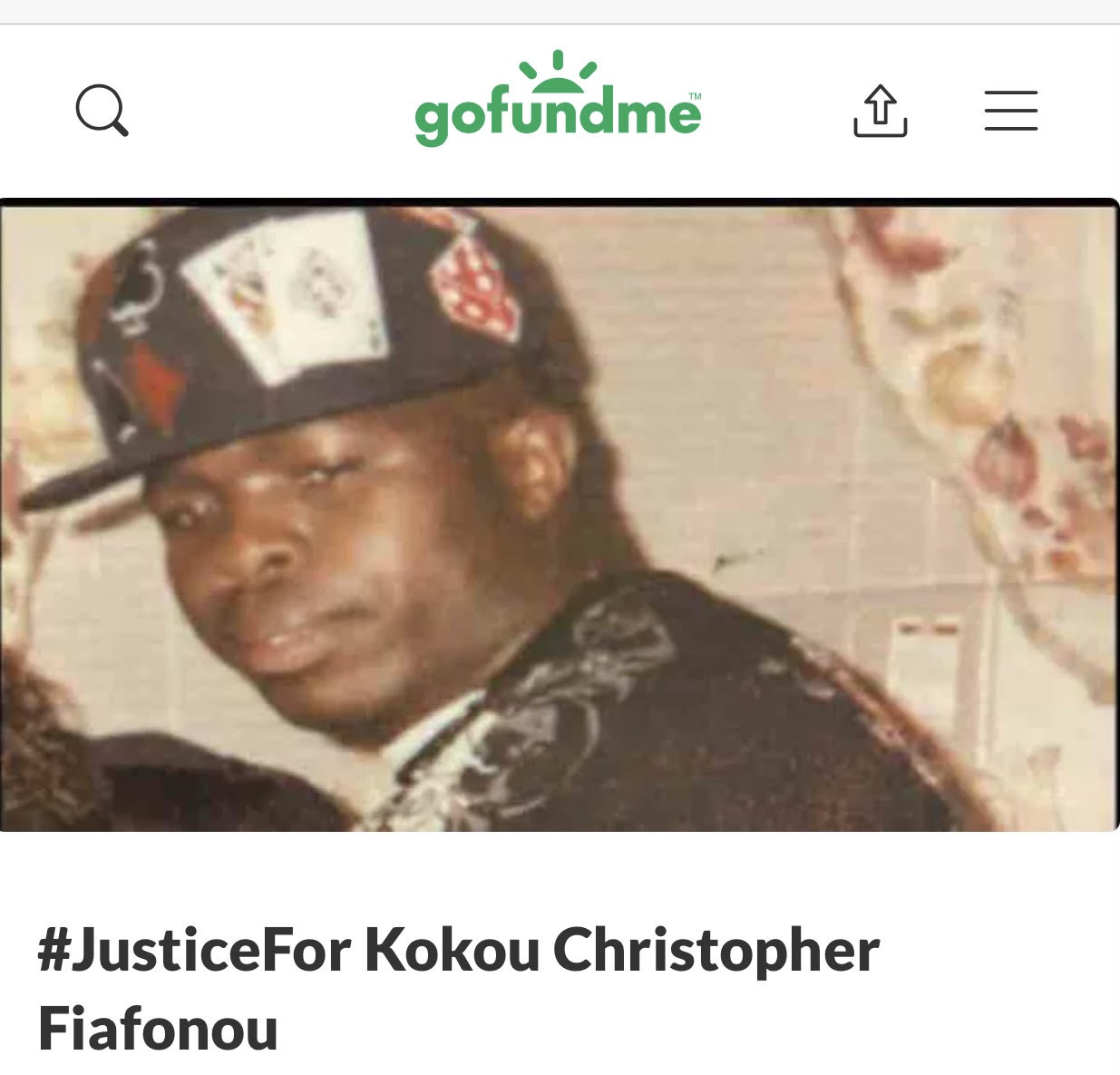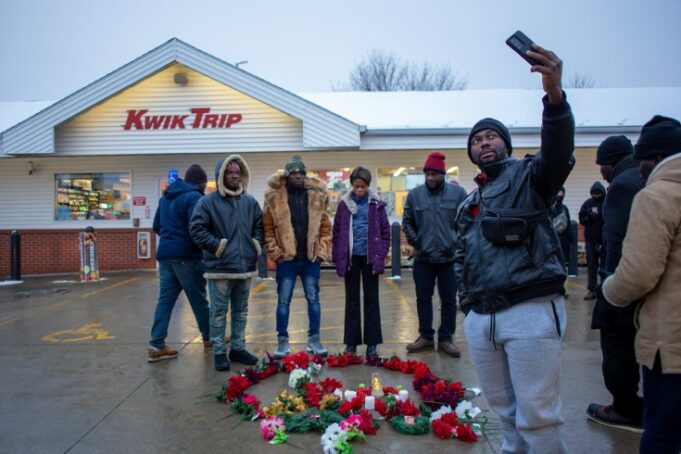by Henry Pan, The Minnesota Spokesman-Recorder
AUSTIN, Minn.—Around 100 people turned out to downtown Austin to demand answers and accountability for yet another Black man shot and killed by a police officer.
Kokou (pronounced ko-ku) Christopher Fiafonou, an immigrant from Togo who moved to Austin from Iowa to work in Albert Lea—20 miles to the west—was shot and killed by an Austin police officer during a standoff at a gas station West of downtown on Dec. 23. The protest was held Dec. 30.
Family members present at the vigil remembered Fiafonou as a kind and spiritual man who, according to a GoFundMe created by a family member, suffered from a mental illness. The vigil was somber and fluid, sometimes tense. The fiancé of Fiafonou was present and was visibly distraught. Family members prayed in a circle while others surrounded them as they prayed.
Demonstrators occupied the intersection of Main St. and 2nd Ave. just outside of the police station; at one point they were met by a White male driver of a white Buick who insisted on driving through the intersection, nearly hitting them.

April Luehmann was in town visiting her sister and mother from Rochester, N.Y., when the killing happened and felt compelled to show support, in part because police also killed a Black man having a mental health crisis in her community. “A kind of very similar [situation] happened in Rochester [with] Daniel Prude, and I was disheartened to hear that it happened again here,” said Luehmann.
Later in the demonstration, protesters tried to make their way into the police station, only to retreat after being told not to by an organizer. “We don’t want to get arrested,” said the organizer. They then gathered in a prayer circle.
Authorities allege that Fiafonou was armed with a knife, threatened to hurt people, and refused to comply with police commands, even after being tasered. The family said what the police did made him scared, and the surviving family, who include Fiafonou’s cousin, his wife, and six children, are homeless as a result.
After the standoff with police, family members say Fiafonou walked out of the home and to the Kwik Trip to get groceries; the utilities to the home were turned off and it would be dangerous to turn it back on with tear gas lingering in the air; for example, turning on electricity could start a fire.
Police caught up with Fiafonou at the gas station and shot him, alleging he was carrying a machete. Fiafonou died at the scene.
“We are calling for the city of Austin to compensate this family for their losses and their losses of their material possessions but also their loss of Christopher,” said Michelle Gross of Communities United Against Police Brutality (CUAPB), who added lost material possessions, including documentation and keepsakes to remember Fiafonou’s cousin’s mother-in-law, who recently passed.
Both the family and CUAPB are raising money to help with funeral expenses, which include repatriating the deceased’s body to Africa. They also need to replace immigration documentation lost because of the officers’ actions that rendered the home uninhabitable.
The officer involved in the killing was identified by the BCA, who is investigating the case, as Zachary Gast. Gast, who does not live in Austin, was one of five officers appointed in October 2019 as part of what the Austin Daily Herald reported as the largest hiring in the department’s history.
No body camera
Gast was not wearing a body camera when he shot Fiafonou because Austin police officers do not have them. According to a June MinnPost article, an estimated 30 to 40 percent of greater Minnesota police departments, including Austin, do not have them. Police departments elsewhere in greater Minnesota who have recently been implicated in officer-involved shootings, such as in Olivia, also do not have them.
The MinnPost article reported the costs and maintenance of the cameras as an obstacle for many small police agencies with a small complement. In Austin’s case, they have 34 sworn officers as of 2021. A proposal at the legislature last session to give grants to departments to buy body-worn cameras never came to fruition.
Parts of the incident were captured on a squad car dashcam, and surveillance cameras exist at the Kwik Trip. The family and CUAPB are demanding that all available footage be immediately released. “While you’re at it, city of Austin, Austin Police Department, release the video right now! If you’ve got nothing to hide, release everything you got right now and stop telling us, ‘Oh, we’re going to the [Minnesota Bureau of Criminal Apprehension],’” said Gross. Kwik Trip did not respond to requests for video footage as of press time.
Austin in transition
Austin is located about 90 miles southeast of Minneapolis and is the headquarters for Hormel Foods, maker of canned pork and ham product SPAM. The city in recent years saw a population and economic resurgence in part as immigrants from West Africa and Southeast Asia moved into the community, predominantly to work in meatpacking. Austin is also home to Hispanic immigrants. According to the 2019 U.S. Census, 17 percent of Austin’s population are immigrants up from 9.7 percent in 2011.
The city’s demographic changes brought with it tension between the newcomers and native Austinians. Sarah Kuichtoch, who is Black, moved to Austin in 2009 to find work while caring for her then-newborn. She is now preparing to sell natural hair products.
Although she likes having a support system in town, the racism makes her uncomfortable. “The downside is the longer you live here, you start seeing the race hate, the hatred for people of skin color,” said Kuichtoch. “I’ve actually had somebody actually pour gasoline on me in a car, and they pretended they were my friends.”
Kuichtoch’s incident is not isolated. In 2020, vandals burned the words “China Virus” onto the lawn of a home owned by a person of mixed Chinese-European descent near downtown. Although Austin city officials say he did not report the incident to the police, he interviewed with local media about it, after which he was subject to internet harassment.
Students of color who wanted to protest the incident involving Fiafonou said they experienced pushback from their White classmates. “[The White dudes] were just arguing with us about [protesting, saying] like why do you need to do that? We don’t even know the full results yet,” said Kelijah Greene, who moved to Austin from Chicago and is a senior at Austin High School.
As activists and family members gathered at the Kwik Trip after demonstrating downtown, they laid roses and artificial candles in the shape of a heart where Fiafonou inhaled his last breaths. While protesters held space, another driver—this time, a White woman driving a red Ford Focus hatchback—tried to drive through the crowd, but was unsuccessful.













